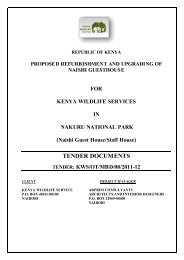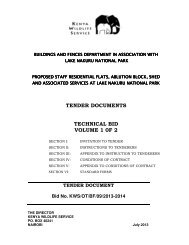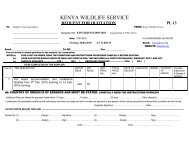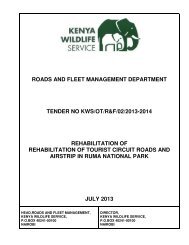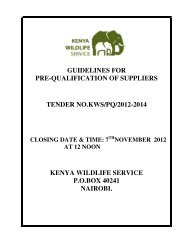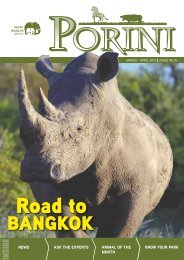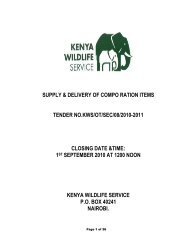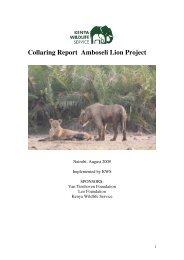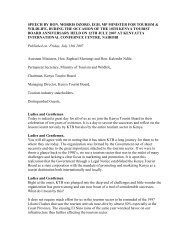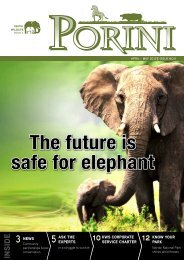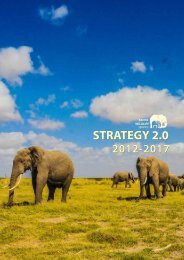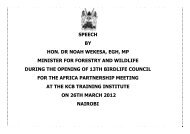Conservation and Management Strategy for the Elephant in Kenya
Conservation and Management Strategy for the Elephant in Kenya
Conservation and Management Strategy for the Elephant in Kenya
Create successful ePaper yourself
Turn your PDF publications into a flip-book with our unique Google optimized e-Paper software.
30 CONSERVATION AND MANAGEMENT STRATEGY FOR THE ELEPHANT IN KENYA<br />
Threat Cause Constra<strong>in</strong>t<br />
Preconditions /<br />
Assumptions (enabl<strong>in</strong>g<br />
conditions /environment<br />
to reduce threats)<br />
Undesirable<br />
impact on habitat /<br />
ecosystem (<strong>in</strong>c.<br />
endangered plant<br />
<strong>and</strong> animal species)<br />
<strong>Elephant</strong>s at high densities with<strong>in</strong><br />
conf<strong>in</strong>ed areas, result<strong>in</strong>g <strong>in</strong> localised<br />
habitat change <strong>and</strong> reductions <strong>in</strong><br />
distribution <strong>and</strong> / or abundance of<br />
species of conservation importance.<br />
• Inadequate security with<strong>in</strong> <strong>the</strong> wider<br />
elephant range (illegal firearm proliferation,<br />
<strong>in</strong>security <strong>in</strong> neighbour<strong>in</strong>g countries)<br />
• HEC (<strong>in</strong>clud<strong>in</strong>g fenc<strong>in</strong>g) result<strong>in</strong>g <strong>in</strong><br />
restriction of elephant distribution<br />
• Loss of corridors <strong>and</strong> habitat fragmentation<br />
through elephant <strong>in</strong>compatible l<strong>and</strong>-use,<br />
Government plann<strong>in</strong>g, loss of specific<br />
critical resources (water, salt lick, high quality<br />
food), lack of wildlife based <strong>in</strong>centives<br />
• Lack of harmonisation of Wildlife Policy /<br />
Act with o<strong>the</strong>r government sectors <strong>in</strong>clud<strong>in</strong>g<br />
L<strong>and</strong>-Use, Agriculture<br />
• Human population growth compet<strong>in</strong>g<br />
<strong>for</strong> l<strong>and</strong> <strong>and</strong> water<br />
• Lack of data on elephant impacts on o<strong>the</strong>r<br />
species <strong>in</strong> fenced/conf<strong>in</strong>ed protected areas<br />
• Lack of <strong>in</strong>tegrated plan <strong>for</strong> <strong>in</strong>vasive alien<br />
plant species (IAPS), grassl<strong>and</strong> management<br />
• Increas<strong>in</strong>g elephant population<br />
• Political stability<br />
<strong>in</strong> <strong>the</strong> region<br />
• Enabl<strong>in</strong>g Wildlife<br />
Legislation/Act<br />
Loss of rangel<strong>and</strong>s<br />
<strong>and</strong> natural<br />
ecological<br />
processes <strong>in</strong><br />
traditional pastoral<br />
community l<strong>and</strong>s<br />
Too few elephants <strong>in</strong> specific<br />
rangel<strong>and</strong>s to provide ecological<br />
or economic benefits<br />
Climate change that lead to loss of<br />
habitat, or more unstable conditions<br />
that lead to more environmental<br />
degradation<br />
• Poverty<br />
• Poach<strong>in</strong>g <strong>and</strong> illegal ivory trade<br />
• Lack of security<br />
• Increased ivory prices / dem<strong>and</strong><br />
• Loss of ecological driver with impacts on<br />
rangel<strong>and</strong> productivity <strong>and</strong> woody<br />
vegetation dynamics.<br />
• No effective global agreement <strong>in</strong><br />
significant reduction <strong>in</strong> CO2 / CH4<br />
emissions<br />
• Effective<br />
site-based<br />
elephant<br />
management<br />
plans<br />
• Stable human<br />
population growth<br />
• Tourism levels<br />
ma<strong>in</strong>ta<strong>in</strong>ed or<br />
<strong>in</strong>creas<strong>in</strong>g<br />
HEC <strong>and</strong> lack of adequate<br />
compensation <strong>for</strong> HEC<br />
• [covered <strong>in</strong> HEC section]<br />
Benefits go<strong>in</strong>g to a m<strong>in</strong>ority of people<br />
(e.g. lodge owners) who often are not<br />
from local communities<br />
• Corruption<br />
• No policy on benefit shar<strong>in</strong>g<br />
Inadequate<br />
socio-economic<br />
benefits result<strong>in</strong>g<br />
<strong>in</strong> negative attitude<br />
towards elephants<br />
Benefits go<strong>in</strong>g to <strong>the</strong> right people but<br />
failure to change behaviour <strong>in</strong> a way<br />
that benefits elephants<br />
Livelihood benefits not l<strong>in</strong>ked to<br />
conservation<br />
Lack of community-based elephant<br />
tourism <strong>in</strong>itiatives<br />
Inequitable distribution of resources<br />
Corruption <strong>and</strong> mismanagement of<br />
resources<br />
• Loss of cultural attachment to elephants<br />
• Poverty<br />
• Lack of appropriate support<br />
<strong>and</strong> resources to communities<br />
• Inappropriate Wildlife Policy/Act



